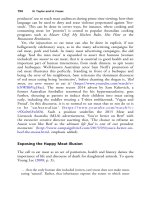The palgrave international handbook of a 339
Bạn đang xem bản rút gọn của tài liệu. Xem và tải ngay bản đầy đủ của tài liệu tại đây (34.33 KB, 1 trang )
Animal Fighting
Claire Lawson
Introduction
This chapter begins with a brief introduction to the subject of animal fighting generally before focusing specifically on dog fighting which, unlike many
other forms of baiting animals, would appear to have remained popular,
despite being illegal in most of the developed world. Evidence, which, in this
chapter, focuses specifically on the UK and the USA, suggests that dog
fighting is the most popular form of illegal animal fighting, and it has also
received the most attention from researchers and civil society (Pet-Abuse.com
2016). It is, subsequently, presented, as a case study in the remainder of the
chapter to illustrate the nature, prevalence, explanations of, and responses to
animal fighting. Initially, an outline of the characteristics of dog fighting, its
prevalence and the categorisation of dog fighters is presented, followed by an
evaluation of the harms experienced by the dogs and the difficulties of
measurement. The different forms of dog fighting such as the informal and
the formal, as well as the rise of a cultural element imported to the UK from
Pakistan, will be discussed. Thereafter, the subculture of dogmen (a term
C. Lawson (*)
Royal Society for the Prevention of Cruelty to Animals & Cardiff University,
Cardiff, United Kingdom
e-mail: LawsonCE@cardiff.ac.uk
© The Author(s) 2017
J. Maher et al. (eds.), The Palgrave International Handbook of Animal
Abuse Studies, DOI 10.1057/978-1-137-43183-7_16
337









